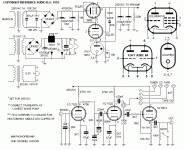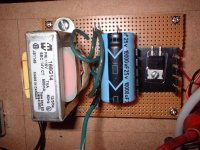Greetings,
I've run into a problem building the 12v filament supply in the attached
drawing. I couldn't find 15v trans. so I got a couple of 14v hammonds.
The problem is the reg. drops the voltage from 14 to about 10.6v.
How do I bump the voltage up to 12.6v.
Thanks
Brian
I've run into a problem building the 12v filament supply in the attached
drawing. I couldn't find 15v trans. so I got a couple of 14v hammonds.
The problem is the reg. drops the voltage from 14 to about 10.6v.
How do I bump the voltage up to 12.6v.
Thanks
Brian
Attachments
Can you check the DC voltage at the input of the 7812 regulator IC? I believe it should be somewhere around 18Vdc. It should provide sufficient volt for the 7812. If the transformer is with CT configuration, you may use 2 diodes for the full wave rectification. This will lower the volt drop across the rectifier circuit.
The total filament current draw should be 0.475A that the 7812 should able to handle.
Johnny
The total filament current draw should be 0.475A that the 7812 should able to handle.
Johnny
The 7812 regulator needs at least 14 volts input to work. With the diode in the ground leg it will want 15. Check the voltage at the input to the regulator, if it is slightly low you can pick up an additional .5 to .8 volts by switching to Schottky rectifiers, they have a lower voltage drop, and are usually quieter.
If that doesn't provide enough voltage, use a low dropout voltage regulator instead of the 7812. The previously mentioned National Semiconductor part is a good option. I use the LM2941, adjustable regulator, but it has 5 pins which makes hand wiring dificult
If that doesn't provide enough voltage, use a low dropout voltage regulator instead of the 7812. The previously mentioned National Semiconductor part is a good option. I use the LM2941, adjustable regulator, but it has 5 pins which makes hand wiring dificult
The voltage before the regulator is about 14.6. After it drops to 10.6.
I tried removing the regulator altogether and added a 8ohm resistor
and that gave me 12.6 exactly but I am worried that I'm deviating too
far from the original design and I'll suffer noise on the phono and line
stage.
I tried a couple of 1n4004's to the ground leg but that only raised a few tenths of volts.
I'll look for LM294X at mouser.
Brian
I tried removing the regulator altogether and added a 8ohm resistor
and that gave me 12.6 exactly but I am worried that I'm deviating too
far from the original design and I'll suffer noise on the phono and line
stage.
I tried a couple of 1n4004's to the ground leg but that only raised a few tenths of volts.
I'll look for LM294X at mouser.
Brian
The 8 ohm resistor is not a bad idea, especially if a reasonably large capacitor is added to ground after the resistor. A resistor in series with the tube heaters limits the inrush current, and promotes longer filament life. I would leave it there, and finish the preamp. Then you can listen for noise.
Briney said:The voltage before the regulator is about 14.6. After it drops to 10.6.
I tried removing the regulator altogether and added a 8ohm resistor
and that gave me 12.6 exactly but I am worried that I'm deviating too
far from the original design and I'll suffer noise on the phono and line
stage.
I tried a couple of 1n4004's to the ground leg but that only raised a few tenths of volts.
I'll look for LM294X at mouser.
Brian
If the voltage is 14.6 volts going into the regulator, it's possible that the 10,000uf capacitor is open or is not connected properly.
Check this capacitor. If your transformer is indeed delivering 14 volts into the full wave bridge and the input capacitor is doing its job, you should see a little over 18 volts at the input of the regulator.
Although well covered here in other posts, at least 5 volts higher than needed on the input side should be used. Line voltages can dip some during different times of the day.
Too large of an input cap will actually produce lower voltage as the transformer can not recover from the repetative peak surge current . I see this condition clearly on a power supply simulator program.
I would just purchase another transformer at 18 volts output and heatsink the regulators. I consider 15 volts AC marginal with a lower current transformer. Obviously, it is.
Too large of an input cap will actually produce lower voltage as the transformer can not recover from the repetative peak surge current . I see this condition clearly on a power supply simulator program.
I would just purchase another transformer at 18 volts output and heatsink the regulators. I consider 15 volts AC marginal with a lower current transformer. Obviously, it is.
Are your Hammond transformers capable of delivering enough current? As tubelab.com asked, when the output voltage of the regulator dips to 10.6 volts, what is the input voltage to the regulator?
I would not use a transformer that produces 18 volts. That would put 25.5 volts at the input of the 7812. Too much voltage drop across the little guy when it is delivering .425 amps.
I would not use a transformer that produces 18 volts. That would put 25.5 volts at the input of the 7812. Too much voltage drop across the little guy when it is delivering .425 amps.
The trannie is 1a (I'm guessing I'm at work, Ill check in two hours when I get home)
I 'll have a look at my wiring, I have plenty of the 10k caps, I'm thinking
they're backwards??
The voltage doesn't appear to change until it gets to regulator so if I'm supposed to have 18v that gives me a couple of things to check.
I 'll have a look at my wiring, I have plenty of the 10k caps, I'm thinking
they're backwards??
The voltage doesn't appear to change until it gets to regulator so if I'm supposed to have 18v that gives me a couple of things to check.
Ok let's see the trannies are 166g14 .5a I tested the caps and they seem to be good.
Here's a photo maybe someone can spot something I'm missing.
I''m thinking of completly dissassembling the 12v supply and trying more breadboarding. I'm have a sneaking suspicion that I'm missing something simple.
Brian
Here's a photo maybe someone can spot something I'm missing.
I''m thinking of completly dissassembling the 12v supply and trying more breadboarding. I'm have a sneaking suspicion that I'm missing something simple.
Brian
Attachments
Hi Guys,
Well I took the filament supply apart and rebuit it and now I'm getting a very
happy 12v!!
I 'm not sure what was wrong but I did change the way I configured the diodes.
Anyhow all well that ends well.
Thanks for your suggestions you made it clear that I had assembled something
all wrong.
Thanks Again
Brian
Well I took the filament supply apart and rebuit it and now I'm getting a very
happy 12v!!
I 'm not sure what was wrong but I did change the way I configured the diodes.
Anyhow all well that ends well.
Thanks for your suggestions you made it clear that I had assembled something
all wrong.
Thanks Again
Brian
1st, I'm pleased that Briney solved his problem.
2nd, tube heads are usually unconcerned about the forward drop in SS diodes. However, at the low voltages associated with filaments/heaters, SS forward drop becomes relevant. IIRC, the forward drop in Silicon PN junction diodes is approx. 1.2 V. OTOH, the forward drop in a Schottky diode is about 0.5 V. So, there a 2 good reasons for using Schottkys in filament/heater supplies: zero switching noise and low voltage loss.
FWIW, I like to construct 12 VDC supplies from a 6.3 VAC trafo whose AC RMS current rating is at least 4X the DC draw. Rectify with a "full wave" voltage doubler made from 2X Schottky diodes, use LARGE caps. in the doubler stack, and follow with 1 or more (depending on total draw) 7812s.
2nd, tube heads are usually unconcerned about the forward drop in SS diodes. However, at the low voltages associated with filaments/heaters, SS forward drop becomes relevant. IIRC, the forward drop in Silicon PN junction diodes is approx. 1.2 V. OTOH, the forward drop in a Schottky diode is about 0.5 V. So, there a 2 good reasons for using Schottkys in filament/heater supplies: zero switching noise and low voltage loss.
FWIW, I like to construct 12 VDC supplies from a 6.3 VAC trafo whose AC RMS current rating is at least 4X the DC draw. Rectify with a "full wave" voltage doubler made from 2X Schottky diodes, use LARGE caps. in the doubler stack, and follow with 1 or more (depending on total draw) 7812s.
- Status
- This old topic is closed. If you want to reopen this topic, contact a moderator using the "Report Post" button.
- Home
- Amplifiers
- Tubes / Valves
- preamp ps problem

